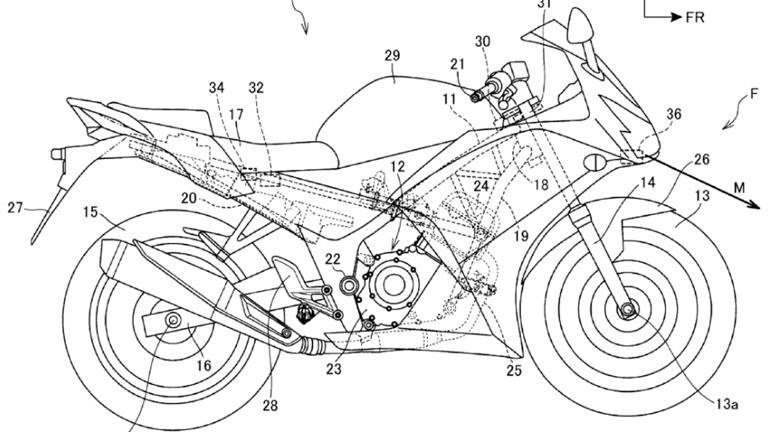Motorcycle technology has come a long way, offering riders not only thrilling experiences but also greater safety features that make every ride more secure and enjoyable. With recent developments in the field, one of the most exciting areas that have caught the attention of technologists and motorcycle enthusiasts alike is the potential for anti-fall mechanisms. Honda, a leader in motorcycle innovation, has filed a patent that could signal the development of such a technology—one aimed at preventing low-speed spills and enhancing overall safety. But what exactly does this patent entail, and how could it impact the way we ride motorcycles in the near future? Let’s take a closer look.
The excitement around this new patent stems from the fact that patents often offer a glimpse into the future of technology, especially in industries like powersports. For years, the powersports world has been abuzz with ideas about how to integrate more advanced systems into motorcycles that could ultimately improve safety, ease of use, and performance. While many patents can be vague or difficult to interpret, Honda’s recent filing has sparked considerable interest and speculation.
One of the key questions raised by the patent is whether Honda is developing a new electronic steering damper, or something entirely different, like a power-steering system for motorcycles. When the patent was first examined, some experts believed it could be a solution to address steering comfort during high-speed turns. However, a deeper look reveals that the solution seems to center on a much more practical issue—keeping the motorcycle upright during low-speed maneuvers, a problem that all riders can relate to.
According to the technical problem described in the patent, the device was designed to address the discomfort that riders experience when performing quick, successive turns in different directions, such as a left turn immediately followed by a right turn. This can cause the rider to feel unsettled or uncomfortable due to a lack of stability, which could lead to difficulty maintaining control, particularly at low speeds.
While this may sound like a relatively minor issue, the implications of such a technology could be significant for new and less experienced riders. The patent describes a solution that uses a steering actuator to apply torque to the suspension apparatus, which controls the steering wheel. The system also incorporates detection means to monitor the motorcycle’s roll angular velocity. Essentially, this means the system can determine if the motorcycle is at risk of tipping over by detecting the angle at which the bike is leaning.
What’s fascinating about this innovation is its potential to intervene and apply torque to the front wheel to keep the bike upright when it detects an imminent fall. By doing so, it could prevent low-speed spills—a common cause of frustration and injury among new riders—by reducing the likelihood of the bike tipping over when there’s too much lean angle or steering input at lower speeds. In simpler terms, this technology could act as a type of anti-fall mechanism, automatically adjusting the bike’s steering to help the rider regain control and prevent a fall.
This breakthrough could be particularly beneficial for beginners struggling with low-speed maneuvers like U-turns, where balancing the motorcycle at slow speeds often proves challenging. With such a system, Honda could make it easier for newer riders to navigate tight turns and urban environments without the constant worry of toppling over. This, in turn, would likely encourage more people to take up motorcycling, as it would reduce some of the inherent risks associated with learning to ride.
But Honda’s patent doesn’t stop at just improving stability at low speeds. The system also includes different control modes, allowing the control apparatus to switch between two distinct steering torque settings. The first control mode applies a predetermined amount of steering torque, while the second mode applies less torque for situations where a more subtle correction is needed. This adaptability gives the system a level of finesse that could allow it to function seamlessly across a wide range of riding conditions.
As with any emerging technology, it’s important to remember that patents often represent concepts that may or may not make it to market in their original form. Nonetheless, the patent provides valuable insight into Honda’s ongoing efforts to revolutionize motorcycle safety. With advancements like these, the future of motorcycling is undoubtedly moving toward more intelligent and intuitive systems that could make motorcycles safer and more accessible for riders of all skill levels.
At this stage, it’s difficult to say how soon this technology will appear in production motorcycles, or what it will ultimately look like in real-world applications. However, the potential for such a system is clear: a motorcycle that can help keep itself upright when it senses the risk of tipping over could drastically reduce accidents, especially at low speeds, and offer new riders greater confidence. It could also be integrated with other Honda technologies, such as the e-clutch system, which could work in tandem to make learning to ride a motorcycle less daunting and far safer.
As an engineer with over 25 years of experience in technology and gadgets, I’m excited to see where this technology goes. The integration of intelligent systems like this into motorcycles is a step toward a safer and more accessible riding experience. For now, we’ll have to keep an eye on Honda’s development of this patent and see how it evolves, but one thing is certain—motorcycle safety is poised for a major upgrade in the years to come.



